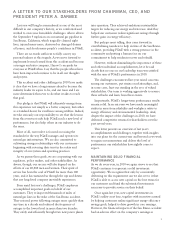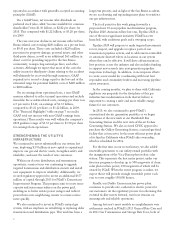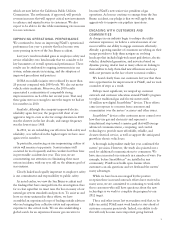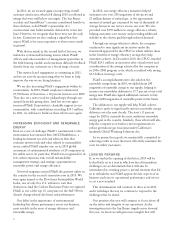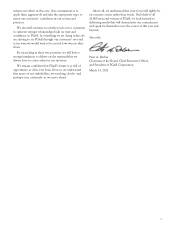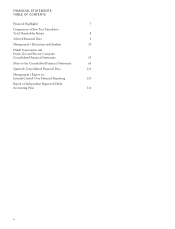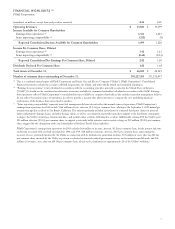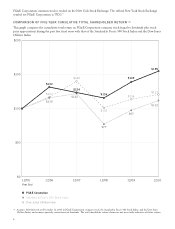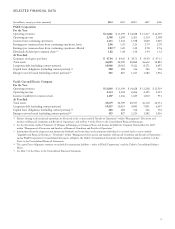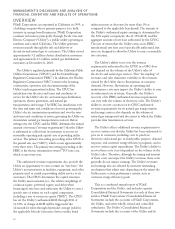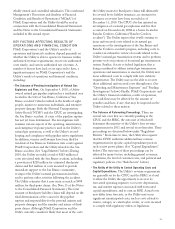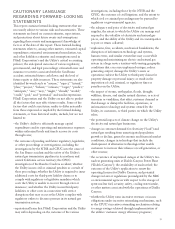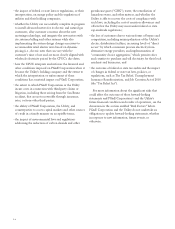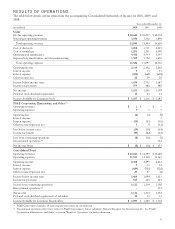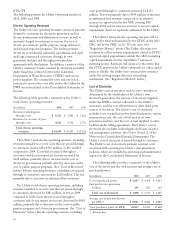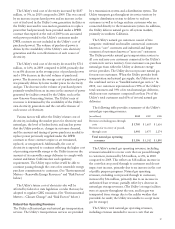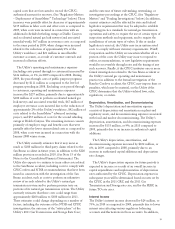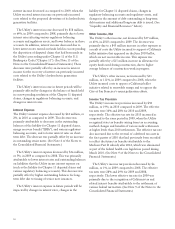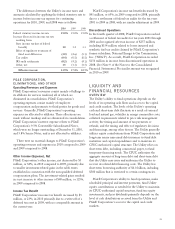PG&E 2010 Annual Report Download - page 15
Download and view the complete annual report
Please find page 15 of the 2010 PG&E annual report below. You can navigate through the pages in the report by either clicking on the pages listed below, or by using the keyword search tool below to find specific information within the annual report.wholly owned and controlled subsidiaries. This combined
Management’s Discussion and Analysis of Financial
Condition and Results of Operations (“MD&A”) of
PG&E Corporation and the Utility should be read in
conjunction with the Consolidated Financial Statements
and the Notes to the Consolidated Financial Statements
included in this annual report.
KEY FACTORS AFFECTING RESULTS OF
OPERATIONS AND FINANCIAL CONDITION
PG&E Corporation’s and the Utility’s results of
operations and financial condition depend primarily on
whether the Utility is able to operate its business within
authorized revenue requirements, recover its authorized
costs timely, and earn its authorized rate of return. A
number of factors have had, or are expected to have, a
significant impact on PG&E Corporation’s and the
Utility’s results of operations and financial condition,
including:
•The Outcome of PendingInvestigations of Natural Gas
ExplosionsandFires. On September 9, 2010, a Utility-
owned natural gas pipeline ruptured in a residential area
located in the City of San Bruno, California (“San
Bruno accident”) which resulted in the deaths of eight
people, injuries to numerous individuals, and extensive
property damage. Both the National Transportation
Safety Board (“NTSB”) and the CPUC are investigating
the San Bruno accident. A cause of the pipeline rupture
has not yet been determined. The investigations will
examine various aspects of the operating, maintenance,
and emergency response practices used in the Utility’s
natural gas operations, as well as the Utility’s record-
keeping and compliance with pipeline safety regulations.
In addition, various civil lawsuits have been filed by
residents of San Bruno in California state courts against
PG&E Corporation and the Utility related to the San
Bruno accident. (See “Legal Matters” below.) During
2010, the Utility recorded a total of $283 million of
costs associated with the San Bruno accident, including
a provision of $220 million for estimated third-party
claims and $63 million of costs incurred to provide
immediate support to the San Bruno community,
re-inspect the Utility’s natural gas transmission lines,
and to perform other activities following the accident.
The Utility estimates that it may incur as much as $400
million for third-party claims. (See Note 15 of the Notes
to the Consolidated Financial Statements.) The total
amount of third-party liability claims will depend on the
final determination of the causes for the pipeline
rupture and responsibility for the personal injuries and
property damages, and the number and nature of third-
party claims. Although PG&E Corporation and the
Utility currently consider it likely that most of the costs
the Utility incurs for third-party claims will ultimately
be covered by its liability insurance, no amounts for
insurance recoveries have been recorded as of
December 31, 2010. The CPUC also has initiated an
investigation of a natural gas explosion and fire that
occurred on December 24, 2008 in a house located in
Rancho Cordova, California (“Rancho Cordova
accident”). The Utility expects that it will continue to
incur unforecasted costs related to its natural gas
operations as the investigations of the San Bruno and
Rancho Cordova accidents progress, including costs to
conduct an exhaustive review of records related to the
Utility’s natural gas transmission system and to perform
pressure tests on portions of its natural gas transmission
system. Further, if state or federal legislation that is
being considered to address natural gas transmission
operations and maintenance is enacted, the Utility may
incur additional costs to comply with new statutory
requirements. The Utility may not be able to recover
these additional unforecasted costs through rates. (See
“Operating and Maintenance Expenses” and “Pending
Investigations” below.) Finally, PG&E Corporation’s and
the Utility’s financial condition, results of operation,
and cash flows may be affected by the amount of
penalties and fines, if any, that may be imposed on the
Utility related to these matters.
•The Outcome of RatemakingProceedings. There are
several rate cases that are currently pending at the
CPUC and the FERC, the outcome of which will
determine the majority of the Utility’s base revenue
requirements for 2011 and several years thereafter. These
proceedings are discussed below under “Regulatory
Matters.” From time to time, the Utility also requests
that the CPUC authorize additional base revenue
requirements for specific capital expenditure projects
such as new power plants. (See “Capital Expenditures”
below.) The outcome of these proceedings can be
affected by many factors, including general economic
conditions, the level of customer rates, and political and
regulatory policies. (See “Risk Factors” below.)
•The Ability of the Utility to Control Operating Costs and
Capital Expenditures. The Utility’s revenue requirements
are generally set by the CPUC and the FERC at a level
to allow the Utility the opportunity to recover its
forecasted operating expenses; to recover depreciation,
tax, and interest expenses associated with forecasted
capital expenditures; and to earn an ROE. Actual costs
may differ from forecasts, or the Utility may incur
significant unanticipated costs, such as costs related to
storms, outages, or catastrophic events, or costs incurred
to comply with regulatory orders or legislation.
11


